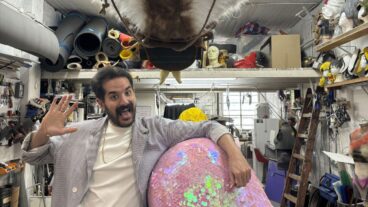After lying in ruins for over 60 years, development is now underway to turn Israel’s first train station into a unique cultural and historical landmark.
Back in 1892 a little steam train that chugged between the Israeli cities of Jaffa and Jerusalem and then back again, changed the face of the Holy Land.
The idea to build the then modern form of transportation came from two Jews, the permission came from the Turkish Sultan, money poured in from wealthy European financiers, and the train was enjoyed by Christian pilgrims arriving to Israel.
The train line — the Jaffa-Jerusalem railway — was one of modern Israel’s first multinational business and tourism projects. Today, about half of the original Jaffa-Jerusalem line is left intact starting at the Tel Aviv suburb town of Bet Shemesh, and winding all the way through the mountains of Jerusalem.
But until recently, the train’s original station known locally as The Tahana (The Station) lay in ruins in the south end of Tel Aviv, a stone’s throw from the Mediterranean Sea.
In a bid to rehabilitate and restore its former glory, and its important historical message, the city of Tel Aviv decided to turn the old buildings of The Tahana, including the old station building, into a park of leisure, culture, entertainment and history.
Bidding on being a part of history
After decades of lying in its decrepit state — since about 1948 when the line stopped working — The Municipality of Tel Aviv-Jaffa reopened The Station to honor the city’s 100 year birthday this year.
Working with the city owned company Ezra and Betsaron, The Station won’t be permanently opened to the public until next year, but vendors, gallery owners, and restaurateurs with a unique and local edge are bidding to be part of the atmosphere.
Eager tourists can already take a peek across the fence to see a flash from the past. ISRAEL21c interviewed Zvika Mintz, founder of Geo Planning, and the urban planner involved in recreating The Station.
Mintz admits he has a particular attraction for the old Israeli landmark. Recently he was in New York where he shared his vision at a meeting with American urban planners at the offices of PPS, Project for Public Spaces.
Mintz believes The Station is important for a number of reasons. For a start, it was Israel’s first major transportation hub. Before that, pilgrims — or anyone — arriving from the Jaffa port on their way to Jerusalem needed to travel by camel or horse: “It became for Christian pilgrims, the most important way to get to Jerusalem after arriving by sea,” says Mintz.
Israel’s first multi-national business project
“It was built with capital from Europe. Not Jewish money,” he explains. “The Turkish gave the license, but investment came from capital in Europe, France and more – it was a cooperative effort” in Ottoman-ruled Palestine.
“[Sir Moses] Montifiore, a Jewish Minister from England had a dream to build this line from Jaffa to Jerusalem and back again,” says Mintz. Later, another Jew took the dream to completion: “[Joseph] Navon went to the Sultan of Turkey since the land at the time was owned by the Turks.
“It became one of the first multi-national projects in this country,” he adds.
The Station changed the lives of the German Templars who had settled in the Jaffa area, allowing them to build factories for tiles and export their products around the country and to Jerusalem.
The train also changed the whole development and face of Jerusalem, enabling steel – for infrastructure – to be transported to the hilltop city for the first time.
No cookie cutter tourist site
Among the famous that travelled on its tracks were architect Franz Yosef, Israel’s father of Zionism Theodor Herzl, and the famous writer Shai Agnon.
Mintz is eager to open The Station to the public — “I want it open tomorrow,” he says — but it will take about a year until the tenders and vendors are in. And it won’t be any cookie cutter tourist site, he promises, unlike the historical Mamilla neighborhood in Jerusalem, which was redesigned only to become another strip mall featuring companies like the clothing chain store Castro, found in every average Israeli mall.
With The Station, “Tel Aviv is saying we are an international town,” says Mintz, and the shops and sites of leisure will reflect that. “Tel Aviv is a city for everyone. And The Station is something cosmopolitan.”
It was a challenge to keep the look and feel of the past, while offering services and amenities for today, but Mintz says he went with the “story of the place.” And shops and galleries will be chosen to paint that picture.
When The Station opens permanently, expect to be transported back in time, but while sipping on cappuccinos, and browsing around shops selling the wares of Israel’s best contemporary designers.
If you listen carefully, you might just be able to hear the blow of the old train whistle as it echoes across the sea.












